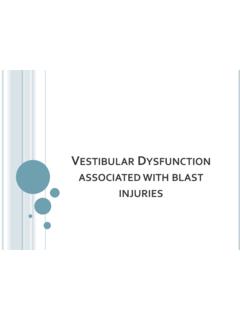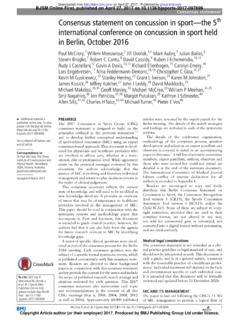Transcription of Cognitive Perceptual Motor Retraining: Remediation of ...
1 Winter 2005 - The journal of Cognitive Rehabilitation5 Cognitive Perceptual Motor retraining : Remediation of Deficits Following Brain InjuryTammy L. WestfallMadhav R. KulkarniKerri J. MooreEdward C. CookMarita Bernardo de LeonTammy L. Westfall, OTR & Kerri J. Moore, OTR, Origami BrainInjury Rehabilitation. Madhav R. Kulkarni, PhD, OTR, LPC & MaritaBernardo de Leon, PhD, Michigan State University. Edward C. Cook,PhD, Psychological & Neuropsychological rehabilitation of persons with brain injury is complex,often requiring comprehensive services from several rehabilita-tion professionals to ensure that multiple problematic areas areaddressed.
2 This article introduces and describes Cognitive Per-ceptual Motor (CPM) retraining , an approach to the treatment ofbrain injury utilized by occupational therapists at Origami BrainInjury Rehabilitation Center and at the Michigan State Univer-sity Rehabilitation Medicine Clinic. Developed by MadhavKulkarni, , , CPM has been utilized for the remediationof deficits in sensory- Motor , Perceptual - Motor , and Cognitive func-tioning immediately following the acquisition of mild to severebrain injury. This approach has also been extremely successfulfor individuals several years post injury or those who have beendischarged from traditional forms of underlying premise of the CPM approach is that per-sons with brain injury should be guided through a process ofreacquiring the spectrum of Cognitive , Perceptual , and Motor skills,from very basic foundational skills through complex cognitiveprocesses, in the same sequence they were first acquired duringnormal development.
3 Treatment is aimed at restoring the dis-rupted brain processes that underlie complex Cognitive opera-tions, in order to promote accurate and efficient functioning(Kulkarni, 1987). The foundation of CPM retraining builds uponthe sensory integration and information processing theories ofLuria (Neurobehavioral Functions), Ayres (Sensory integration),and Piaget ( Cognitive Development), as well as other PrinciplesCPM retraining has several key principles (Kulkarni, 1993):(1) The brain can recover function through environmentalstimulation (plasticity of the brain).
4 (2) The reacquisition of skillsis hierarchical and must follow the path of their originaldevelopment, requisite skills need to be remediated prior tohigher-level skills. (3) The therapeutic regimen must be graded inspeed, complexity, and duration in order to ensure success,promote adaptation, and improve competencies. (4) Feedbackpromotes self-awareness and refinement of skills. (5) Activeparticipation in meaningful and purposeful activity with additionalconsideration for feelings, attitudes, and behaviors, promotesmotivation.
5 (6) Practice, with and without variation, facilitatesthe reacquisition of skills, and aids in the reorganization offunctional systems of behavior. (7) Metacognitive processesshould be promoted to increase of the TherapistA therapist utilizing the CPM approach must keep theaforementioned principles in mind from the time of the initialevaluation until the termination of services. When working withindividuals with a brain injury, the therapist will most likely needto address the behavioral manifestations that may be present.
6 Asuccessful therapist incorporates therapeutic use of self bymodeling appropriate behavior, overcoming one s instincts tooverreact, remaining calm, using slow speech, and being as tactfulas possible (Frank, 1958). The therapist should attempt to promoteconsonance among the three selves of the individual, the actingself, perceived self, and the ideal self. A person with a braininjury may have difficulty integrating who they are (acting self)who they think they are (perceived self), and who they want tobe (ideal self).
7 The use of metacognitive processes, such as theuse of W questions, who, what, when, where, and why, andopen ended questions regarding the client s view of their ownperformance, brings additional self-awareness, a key factor inpromoting the integration of the three selves. The therapist mustfacilitate the client s positive outlook on therapy by empoweringhim or her to make decisions and identify realistic goals pertinentfor the quality of life they should be noted that although the CPM retrainingapproach was originally developed to be used by occupationaltherapists, it may be, and has been, used by other cliniciansintensively trained in the CPM approach such as psychologistsand speech language pathologists.
8 In this article, therapists refer to any CPM-trained CPM Evaluation ProcessThe CPM evaluation is a multifaceted process requiring atherapist to be thoroughly trained in CPM. This is because thetherapist is the most influential variable in the assessment process(Kulkarni, 1993). Building therapeutic rapport, explaining thetesting procedures in detail, and providing immediate feedback,will assist in easing test anxiety, fostering confidence in thetherapist s ability, and increasing deficit initial CPM evaluation consists of an initial interview,formal assessments of Cognitive , Perceptual , and motorcompetencies, and informal assessments/clinical typical evaluation lasts three to four hours.
9 With additional6 Winter 2005 - The journal of Cognitive Rehabilitationtime needed to generate scores and interpret data. The evaluationdetermines current functional status, including both strengthsand Clinical InterviewThe clinical interview gathers a brief medical and treatmenthistory from the client. A report of the problem areas, specificallyin basic and instrumental activities of daily living, is formulatedthrough the use of open-ended questions. The individual spremorbid and current life roles, support systems, educationalbackground, cultural influences, employment status, and hob-bies/interest areas are gathered.
10 This information assists the thera-pist in ascertaining the client s level of deficit awareness andreality orientation. The final stage of the initial interview involvesthe client stating his or her rehabilitation goals. This stage iscritical because it guides the treatment process. Goals of return-ing to work versus independence at home may have a differingtreatment emphasis. It is important to note that family membersare encouraged to participate in the clinical interview, especiallyif the client has deficits in communication and/or the objective testing portion of the evaluation begins,time is allotted for the client to ask any questions he or she mayhave for the therapist.






